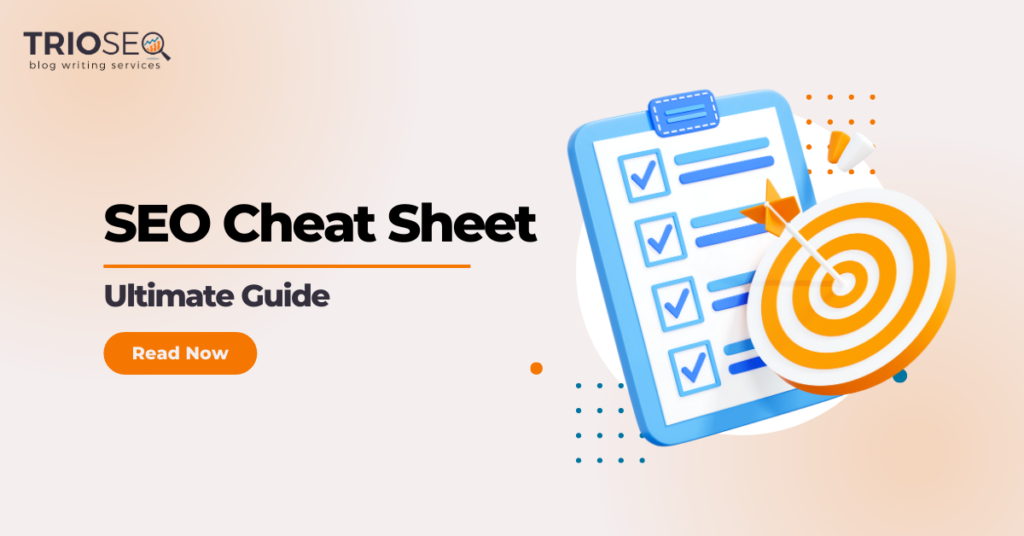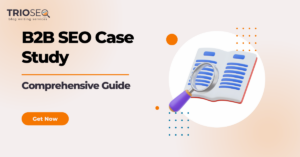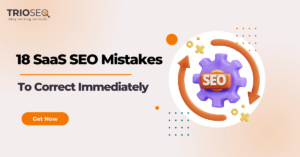Does Search Engine Optimization (SEO) seem tangled and complex, like you need an SEO cheat sheet to succeed? It’s time to dissipate the smoke and mirrors.
Today, we will unravel the art of SEO – yes, we call it an art because while there are rules, it demands creativity.
Our cheat sheet is a compact guide housing the best practices that benefit your site’s rankings. Let’s consider it your roadmap from here on out and get started.
Types of SEO
SEO is a critical component of any effective marketing strategy and can be divided into three categories that cater to your website’s visibility and rank.
Let’s dive into them individually.
On-Page SEO
The first type on our SEO cheat sheet is on-page SEO, which denotes optimizing individual web pages to improve their ranking and drive traffic to your website.
Several on-page factors contribute to these efforts – title tags, content quality, internal linking, keyword utilization, and image optimization are prime examples.
Tasks in on-page SEO revolve around simplifying user navigation and optimizing search crawler accessibility.
Off-Page SEO
Off-page SEO relates to all activities performed outside your website that contribute positively to its SERP ranking.
The central aspect here revolves around building high-quality backlinks — recommendations from other websites suggesting yours as a valuable source of information, which enhances your domain’s credibility.
Moreover, social media marketing strategies form an integral part of off-page SEO. Local SEO strategies also fall under this category; for a business with physical locations or one providing localized services – appearing in local searches is a game-changer.
Technical SEO
Last but by no means least comes technical SEO – one might consider it more backend-oriented compared to its counterparts.
A smooth website requires tackling technicalities like fast page speeds, implementing user-friendly site structures, and eliminating duplicate content issues. Remember that SERPs value sites that perform well across multiple devices – mobile responsiveness strategies also fall perfectly under this bracket.
Further down the rabbit hole lies advanced techniques such as XML sitemap creation and executing schema markup arrangements, which facilitate better indexation, making it easier for search crawlers to comprehend your website’s offerings.

SEO Best Practices
Below are some SEO best practices to remember when optimizing your website.
Respect Readers’ Time and Patience
Give your readers what they want without making them jump through unnecessary hoops. Ensure your content is impactful, concise, and relevant to their search. However, quality should never be sacrificed for brevity; provide value in all content you create.
Keyword Must Be Relevant
Ensure the keyword matches your content to optimize your website or blog effectively. A relevant keyword attracts more visitors interested in that specific information or service.
Wait a minute- does blogging help SEO? Find the answer to that question in our ultimate guide.
Treat Every Page as a Landing Page
Remember that only some visitors land on your homepage first. Consequently, all pages must have straightforward navigation to other pages. Ideally, each page should stand alone in offering valuable content even while it complements the overall theme of your site.
Get Familiar with On-Page SEO Factors
Understanding on-page SEO helps you better optimize pages, which results in higher ranks and visibility on Search Engine Results Pages (SERPs). Some crucial focus areas include title tags, headers, and meta descriptions.
Establish Exceptional User Experience
SEO isn’t just about increasing visibility and rankings—it’s also about improving user experience (UX). These two are intertwined: a good UX leads to lower bounce rates and longer dwell time—all positive signals that can impact rankings positively.
Optimizing a website isn’t simply about ticking off tasks from a list—it’s a strategic endeavor. A spreadsheet or web dev cheat sheet could help handle this efficiently while avoiding common pitfalls.

On-Page SEO Cheat Sheet
Often underestimated, on-page SEO plays a crucial role in optimizing your website.
Below is an in-depth checklist that includes several key elements.
Title Tag Optimization
Starting with title tag optimization is the cornerstone of on-page SEO factors. Its function is dual-sided, serving as a strong relevancy signal to search engines and providing users with a precise snapshot of what your content deals with.
- Keep your title tags within 50-60 characters.
- Make sure to include your primary keyword, preferably towards the beginning.
- Ensure each title is unique to prevent duplication issues.
- Provide informative yet concise titles that accurately describe the page’s content.
Optimize Headings
Moving ahead from titles, we run into headers, which carve out the structure of your content for both search engines and users alike.
- H1 tags should be reserved for main page titles.
- Subsequent headers (H2-H6) denote different sections or sub-topics within the content.
- Keywords should be smartly incorporated into these headers, but avoid keyword stuffing.
Search Intent Optimization
Ranking well isn’t just about embedding relevant keywords; it’s about aligning with user intent – essentially catering to what the audience is looking for from the start.
- Determine if users want informational, transactional, or navigational content using tools like Ahrefs or SEMrush.
- Tailor new (and existing) content around these identified intents.
Keyword Optimization
The heart of SEO success is intelligent keyword use. The balance is vital: staying relevant and keeping the right keyword amount without losing reader interest.
- Use long-tail keywords: They often have less competition and better conversion rates due to their specific nature.
- Latent Semantic Indexing (LSI): These semantically related keywords help Google understand contextual meaning – use them wisely throughout, especially since recent shifts away from exact match phrasing! For example, an LSI keyword for “car” is “vehicle.”
Meta Description Optimization
Meta descriptions are short overviews of your web pages that appear below your URL on search results. There are essential SEO tools that can significantly boost click-through rates when done well.
- Add your primary keyword once
- Limit meta descriptions between 150-160 characters, including spaces
- Stay authentic! Duplicate meta descriptions can get penalized by Google algorithms
Image Optimization
Powerful visuals enhance user experience and attract traffic – transforming images from simple design elements into ranking giants is necessary.
- Use original images whenever possible instead of generic stock photos
- Always include alt text, again carefully integrating various types of keywords
- Compress image file size without hampering quality for faster loading times
Internal Linking Optimization
Lastly, let’s talk about internal linking. It’s a powerful method to guide visitors to other valuable parts of your site, controlling how link power spreads internally.
It’s a critical on-page SEO tactic recognized worldwide. You strengthen your SEO approach by linking related articles and using the right anchor texts.
Speaking of internal linking, check out some related articles:
- What are SEO OKRs?
- What are the pros and cons of SEO?
- Ultimate Guide to Content Briefs
- Best SEO Software for a Small Business

Off-Page SEO Cheat Sheet
To climb search engine rankings, we must look beyond our website. That’s where off-page Search Engine Optimization (SEO) comes into play.
Besides enhancing website relevance and authority, it also drives referrals and valuable backlinks.
Here are some strategies that you need to work on to elevate your site’s off-page SEO performance.
Building Backlinks
Establishing a robust backlink profile is one of the highest contributing factors for successful off-page SEO. Backlinks lend credibility to your site, acting as popularity votes from other websites.
Below are some critical areas of our SEO cheat sheet dedicated to building solid backlinks:
- Digital Assets Creation: Develop online tools like calculators and quizzes to attract and engage users.
- Case Studies & Statistics: Craft articles centered on fresh stats and urge individuals to refresh their citations.
- Broken Link Building: Scout for malfunctioning links on various sites and recommend your relevant page as a solution.
- Infographics Development: Design informative and captivating visuals and encourage others to link to them.
- Content Creation: Produce engaging materials and spread the word to maximize reach.
- Guest Blogging: Contribute articles to external platforms and ensure a link to your site.
- Public Relations (PR): Collaborate with influencers and PR specialists to amplify your brand’s voice.
- Competitor Analysis: Investigate who’s backing your competitors with links and then approach them for potential linking opportunities.
Remember, not all backlinks carry equal weight; their value hugely depends on referring domains’ authority.
Social Media Strategies
Aside from communication channels, social media platforms influence website ranking through indirect metrics like audience engagement, brand awareness, and trust signals.
Below are some best practices to boost social signals:
- Post Regularly: Consistent posting broadens reach and reminds followers about your brand.
- User Engagement: Encourage conversations by asking thought-provoking questions or hosting polls.
- Platform-Specific Formats: Tailor posts according to each platform’s formats.
With an effective social media strategy, you can amplify your online presence, which impacts SERP visibility.
Local SEO Strategies
Local SEO shouldn’t be overlooked if you’re running a locally-focused business. It helps search engines pinpoint your location(s), thus making it easier for potential clients nearby to discover you when searching.
Here are three primary local SEO strategies:
- Google Business Profile: First things first – Claim and complete information.
- Local Reviews: Encourage customers to leave reviews—an excellent referral strategy attracting organic traffic.
- Website Localization: Optimizing landing pages by incorporating region-specific keywords and info makes reaching out more accessible.
By following these tips, you’ll see noteworthy improvements. Remember, though, always strive for strategic updates, keeping up with prevailing trends.

Technical SEO Cheat Sheet
In the matrix of search engine optimization, technical aspects form a vital cornerstone.
Multifaceted and intricate, this element of our SEO cheat sheet cannot be underestimated. Let’s get started on dissecting each component.
Page Speed Optimization
An inevitable part of optimizing your website for better search rankings is taking care of page speed.
According to a study, 53% of visitors abandon a page if it takes longer than three seconds to load, emphasizing the critical role speedy loading times play in user experience and bounce rates.
- Minimize HTTP Requests
- Reduce server response time
- Employ Gzip compression
- Leverage browser caching
- Optimize images
Remember that speed is not just a desktop affair; Google incorporates mobile page speed into its ranking algorithm.
Site Structure Optimization
Next up is site structure optimization—an area many overlook.
Your site should be organized clearly, making navigating easy for users and search engines.
- Use a simple directory structure
- Implement breadcrumbs navigation
- Maintain URL simplicity
- Balance the number of links on each page
A logically structured website heightens UX and bolsters crawling efficiency—making your pages appear more relevant during searches.

Avoid Duplicate Content
Google categorically dislikes duplication! Repetitive content often penalizes you and hampers your visibility in SERPs (Search Engine Results Pages).
It’s best practice to:
- Regularly audit your website for duplicate content using tools like Google Search Console.
- Make use of canonical tags properly so Google knows which version to rank
- Consistently create unique, engaging content that adds value
Remember, originality isn’t just virtuous for authenticity’s sake—search engines love it!
Multilingual SEO Strategies
Multilingual SEO helps extend your digital reach beyond linguistic barriers—it ensures inclusion in diverse markets by targeting keywords tailored to various languages and regions:
- Use hreflang tags correctly — these inform Google which language you’re using on specific pages such that it presents them accurately to geo-targeted users.
- Localize URLs with appropriate keywords instead of translating directly.
- Create localized keyword lists rather than merely translating from one language into another.
Globalization has made multilingual SEO crucial for reaching international audiences.
Mobile Responsiveness Strategies
With mobile browsing accounting for over half of all web traffic worldwide, according to Statista data, designing your website with mobile-friendliness at heart is essential—not optional!
Ensure:
- Dynamic serving: The same URL serves different HTML depending upon whether visiting from a desktop or smartphone environment,
- Responsive Web Design (RWD): Designs automatically adapt based on screen size,
- Reduced use of Flash: Many mobile devices don’t support Flash.
Mobile-first indexing means treating mobile versions as primaries instead of just viewing them as afterthoughts or secondary renditions—make sure yours doesn’t miss out!
XML Sitemap Creation
Navigating through websites can sometimes seem akin to navigating mazes.
By creating an XML sitemap – essentially a roadmap aiding search engine bots in understanding your website hierarchy—you ease their job tremendously.
A comprehensive XML sitemap usually includes every accessible URL within your domain

Common Mistakes to Avoid in SEO
In mastering SEO, you might stumble upon some common missteps.
Understanding these pitfalls is crucial for enhancing your website’s performance and achieving better rankings.
Below are some mistakes:
Ignoring On-Page SEO Factors
There can be a tendency to overlook crucial on-page SEO factors such as title tag optimizations and meta descriptions. These details vastly influence search engine rankings and should always be supported in your optimization cheat sheet.
Neglecting Quality Content
Unfortunately, it isn’t rare for beginners to focus solely on keyword optimization and neglect the importance of crafting high-grade content. It’s essential to remember that delivering valuable content remains the heart of any successful SEO strategy.
Overlooking Mobile Responsiveness Strategies
The user experience should always be seamless across all devices. A common mistake is disregarding mobile responsiveness strategies, negatively impacting your site’s accessibility on smaller screens.
Failure to Implement a Link Building Strategy
Securing quality backlinks is a robust off-page SEO activity that augments domain authority. Not integrating an effective backlink strategy is a missed opportunity and a potential drawback.
Missing XML Sitemap Creation
Among numerous web dev cheat sheet items, one commonly overlooked point pertains to XML sitemap creation—an essential facet of a viable technical SEO approach.
Inappropriate Use of Keywords
A prevalent blunder made specifically in on-page SEO activities is stuffing keywords. While keyword optimization is pivotal in improving rankings, their excessive or unrelated usage can adversely affect readability and lead to penalties from Google.
Disregarding Multilingual SEO Strategies
If applicable globally or multi-nationally, disregard for multilingual SEO strategies could hinder outreach efforts within non-English speaking markets—diminishing potentially enormous swaths of audience interaction opportunities.

Conclusion
SEO remains critical in boosting visibility and audience reach as we navigate digital landscapes.
This SEO cheat sheet is your go-to guide to ensure your website ranks high on search engine results.
Remember, fine-tuning each part of these three categories aids in crafting an optimized and search-friendly site.




![Featured Image - Mental Health Content Writing [Best Practices and Ethical Considerations]](https://trioseo.com/wp-content/uploads/2024/05/Mental-Health-Content-Writing-Best-Practices-and-Ethical-Considerations-300x157.png)
![Featured Image - Beginner’s Guide to CBD Content Writing [Tips Included]](https://trioseo.com/wp-content/uploads/2024/05/Beginners-Guide-to-CBD-Content-Writing-Tips-Included-300x157.png)

![Featured Image - [Ultimate Guide] SEO For Tech Companies That Outranks Competitors](https://trioseo.com/wp-content/uploads/2024/04/Ultimate-Guide-SEO-For-Tech-Companies-That-Outranks-Competitors-300x157.png)

![Featured Image - B2B SaaS SEO - Ultimate Guide [Strategy Included]](https://trioseo.com/wp-content/uploads/2024/04/B2B-SaaS-SEO-Ultimate-Guide-Strategy-Included-300x157.png)

